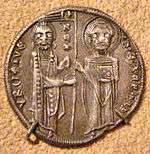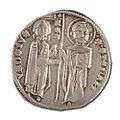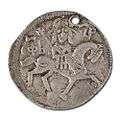Medieval Serbian coinage
The first mention of a "Serbian dinar" dates back to the reign of Stefan Nemanjić in 1214. Until the fall of the Serbian Despotate in 1459, most of the Serbian rulers minted silver dinar coins. The first Serbian dinars, like many other Southern European coins, replicated Venetian grosso, including characters in Latin (the word dux replaced with the word rex). For many years it was one of the main export articles of medieval Serbia, considering the relative abundance of silver coming from Serbian mines. Venetians were weary of this, and Dante Alighieri went so far as to put the Serbian king of his time, Stefan Milutin, in Hell as forgerer (along with his Portuguese and Norwegian counterparts):
E quel di Portogallo e di Norvegia lì si conosceranno, e quel di Rascia che male ha visto il conio di Vinegia.

Emperor Stefan Dušan adopted the Byzantine hyperpyron (perper), a large unit of currency: the imperial tax was one perper per year per house.[1]
Gallery
 Dinar of Stefan Uroš I (r. 1243–1276).
Dinar of Stefan Uroš I (r. 1243–1276). Dinar of King Stefan Dragutin (r. 1276–1282).
Dinar of King Stefan Dragutin (r. 1276–1282). Dinar of King Stefan Milutin (r. 1282–1321).
Dinar of King Stefan Milutin (r. 1282–1321). Dinars of King Stefan Uroš III (r. 1321–1331).
Dinars of King Stefan Uroš III (r. 1321–1331). Dinar of Emperor Stefan Dušan (r. 1331–1355).
Dinar of Emperor Stefan Dušan (r. 1331–1355).
See also
| Wikimedia Commons has media related to Medieval Serbian coins. |
References
- Vladimir Ćorović: Историја српског народа Archived 2015-09-24 at the Wayback Machine: V.I Турски замах Archived 2015-09-24 at the Wayback Machine
Sources
- Vesna Radić (1994). Eight Centuries of the Serbian Dinar: Medieval Coins. Belgrade: National Museum.
- Sergije Dimitrijević (1997). Srednjovekovni srpski novac. SANU.
- Miroslav M. Jovanović (2012). Srpski srednjovekovni novac. ISBN 978-86-902415-3-8.
- Marija Jovanović (1990). Srpski srednjovekovni novac. Fotograf.
- Ivanišević, Vujadin (2001). Новчарство средњовековне Србије. Belgrade.
- Odak, Marina I. (2015). "Ikonografija i simbolika predstava na srpskom srednjovekovnom novcu". Belgrade: Filozofski fakultet.CS1 maint: ref=harv (link)
- Cvjetićanin, Tatjana, ed. (2008) [2003–2004]. "Numizmatičar". 26–27. Belgrade: National Museum. Cite journal requires
|journal=(help)